Product Pitch Example
1: Executive Summary
Little Beanie aims to provide its customers with both the pleasure of listening and experiencing live music as well as enjoying well-made coffee and food. While doing this the company will help local music education programmes and the underage population unable to enjoy music in bars.
The company will commence in the winter of 2017 and will be owned and ran by Simone Boorman and 7 other employees. The employees will all be paid NMW in accordance with their age and work both full and part time. Despite looking like, a small team, the company believes it is enough for the first year.
Little Beanie plans to:
- Provide a medium for local artists to present their music to the local people.
- The create a unique coffee shop experience in adding music to the mx and through this become real competition to local competitors.
- Eventually open more floor space upstairs and start selling hot food.
With the increasing problem that the area is experiencing due to lack of space for music lovers to play, Little Beanie provides a solution to this problem while other offering more in the form of food and drink.
The business will mostly rely on word of mouth and social media to promote itself, however we do not see this as a problem due to the uniqueness and the power of social media in 2017.
Little Beanie will be located at 19 Stone Row, Coleraine, with all legislation and legal issues taken care of.
Little Beanie has taken itself through the different Marketing, Operational and Financial planning necessary to become a successful business. Also, risks in each sector have been identified and a risk management plan has been addressed to tackle these risks if they are to ever come to light.
2: Company Overview
- Mission Statement
Little Beanie’s is an acoustic coffee shop offering a range of coffee and traybakes as well as the pleasure of live music from open to close. Little Beanie hopes to build on the existing coffee trend, currently worth over £6.2 billion (News, 2017) and inspire customers to come encourage local artists, helping them progress in their careers.
- Vision Statement
Little Beanie’s vision is to create a place for young artists to establish themselves while also providing a place for customers to enjoy a break. Companies that are serious about turning a vision into a reality need to involve their employees (Chaneski, 2011), who at Little Beanie happen to be local artists. Through creating a company that offers not only coffee and treats but live music from these artists, a comfortable environment will be created for all. Beginning in Coleraine, Little Beanie plans to expand all over Northern Ireland where the music scene is rife.
- Product/ Service Details
The range of products and services provided by Little Beanie includes:
- A range of coffees made by expertly trained baristas and a range of traybakes available
- Not only is coffee offered but also a variety of other hot drinks including, teas and hot chocolate, as well as a variety of popular soft drinks.
- A one of a kind experience, the ability to be able to listen and enjoy live music from local artists while enjoying their purchase.
- The ability to become the entertainment themselves, local talent can audition and receive an income, rather than busking on the streets.
- These prices will be provided from menus on the walls.
- The shop will be open from 10am to 10pm Monday to Thursday, 10am to 11pm Friday and Saturday and then 11am to 8pm on Sundays.
- There is a stage located at the back of the shop with a sitting area allowing a great view of the entertainment from every angle.
- Live music is free every day with a donation box sit out for any generous customers, with the money collected going straight to the artists. Only acts after 7pm on Fridays and Saturdays are charged with a small fee of £8 to see the more in demand artists.
- It is a cash only service as cash machine is 20 sec walk from building.
2.4 Key Selling Points
- Located 10 seconds from a carpark, with the government parking charge until 6pm allowing free parking for late night coffee drinkers.
- Ability for teenagers under 18 to enjoy music which they cannot do in the over 18 bars, the usual music venues.
2.5 Distinctive Competence
Distinctive Competence and competitive advantage of a company are concepts critical to the strategic thrust and eventual success of a small business (Stoner, 1983). It is a homegrown business, appealing to customers due to the homely feel and friendly staff. It is unique in the market place as the only coffee shop in the area that provides live music always, for no price all week and a small sum at the weekends.
2.6 Future Plans
Short Term- In the short term of Little Beanie, the plan is to keep the business running paying off loans and increasing profit through advertising on social media. Staying up and running is the main priority with maybe exploring the introduction of an upstairs sitting area.
Long Term- In the long term, the plan is to introduce more of a variety to the menu, including food such as paninis and a variety of other hot foods. Also, consider the possibility of expanding around Northern Ireland.
3: Market and Industry Analysis
3.1 Target Market
Little Beanie believes that coffee and music is something that will always have interest. The world is always changing. With change comes opportunity, but humans don’t change. Their needs remain the same (Magdalein, 2011). With this, the company sought to find their target market between 11-50. They originally targeted teenagers unable to attend gigs due to the age limit at bars, a growing problem in Coleraine due to increasing government programs helping teens to use their musical talents but nowhere for them to play/enjoy music. Yet through Primary research it found that 40+ are also a big part of the market.
3.2 Primary Research
We carried out an online questionnaire (appendix 1) shown in figure 1. Collected 63 responses and the results showed the following.
-
 Found that most respondents were between the age bracket of 18-25 with a 33.33% response rate and 40+ with a 38.10% response rate.
Found that most respondents were between the age bracket of 18-25 with a 33.33% response rate and 40+ with a 38.10% response rate.

-
 A clear majority of 89% of respondents saying they would be interested in live music with coffee, showing there is a demand.
A clear majority of 89% of respondents saying they would be interested in live music with coffee, showing there is a demand.

- Primary research was used to explore coffee prices, asking customers what they would be willing to pay and allowing suggestions that were considered when creating the menu.



3.3 Secondary Research
Little Beanie belongs to the Hospitality and Catering Industry, which was investigated further and a summary of key findings is provided:
- According to Project Café13 UK, the branded coffee chain segment recorded £2.6 billion turnover across 5,531 outlets (News, 2017).
- 1 in 5 coffee shop visitors visit coffee shops every day, drinking an estimated 1.7 billion cups of coffee per year in coffee shops (News, 2017).
- Allegra foretells the total UK coffee shop market will exceed 20,500 outlets and it is estimated that the UK has the potential to host more than 9,500 branded coffee shops (News, 2017).
3.4 Competitor Analysis
Little Beanie has identified the biggest competitor is Ground Coffee, a branded coffee shop in Northern Ireland. Firms sometimes deviate from consumers’ views and focus on other firms not identified by consumers (Kim and Tsai, 2012) and this is exactly what the company was afraid competitors will do (see more detail in 5.8). A SWOT analysis comparing the competitor’s strengths and weaknesses was created:
 SWOT Analysis
SWOT Analysis
Porter’s Five Forces
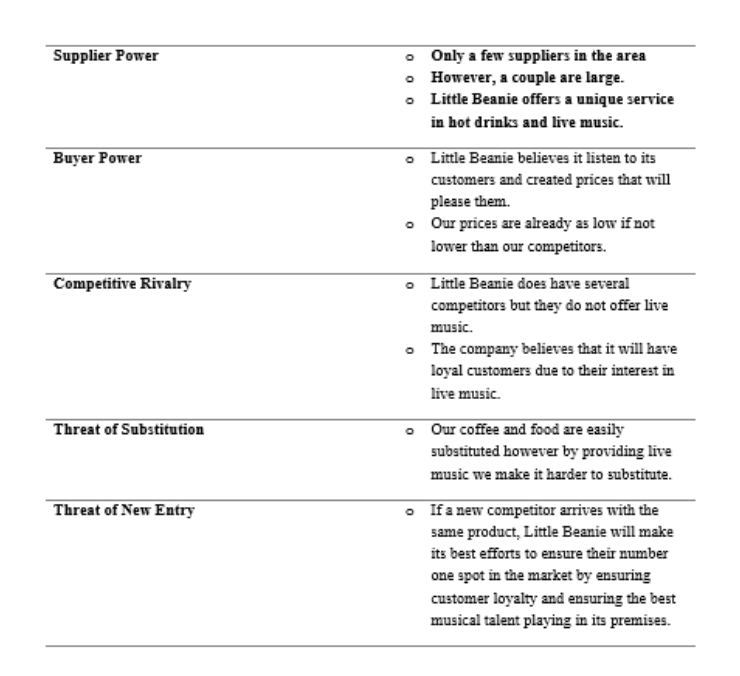
Not one of its competitors provide Live Music.
4: Marketing Plan
A Sales and Marketing Plan emphasizes how to approach your customers using pricing and promotional tactics (Stewart-Allen, 1997). However, there is more to marketing than simply hanging a flyer or distributing a bookmark (Tucker and Duke, 2007), Little Beanie have used the Marketing Mix and the 3 service Ps to make the 7 Ps and explain their marketing plan and how it is more than just this.
 4.1 The 7 Ps
4.1 The 7 Ps
4.2 Price Strategy
A company sells several different items to a set of customers, implementing a new set of prices in one single step might not be desirable as there is plenty of market research to take place, prices charged must please the target market (Berger, Grigoriev and van Loon, 2011). From Little Beanies market research the business could create a price list (see Appendix 2).
5: Operations and Legality
5.1 Operations Strategy
Operations strategy is formed via complex processes that transpire in multiple directions at multiple organizational levels (Kim, Sting and Loch, 2014). The Operations Strategy at Little Beanie is to provide the customer with what they want, and use the following operations to achieve that. Prices have been tailored to become some of the cheapest in the area and there’s a competitive advantage with the novelty of an ‘acoustic’ coffee shop. The following operations are also put in place to achieve the customers wants.
5.2 Staff
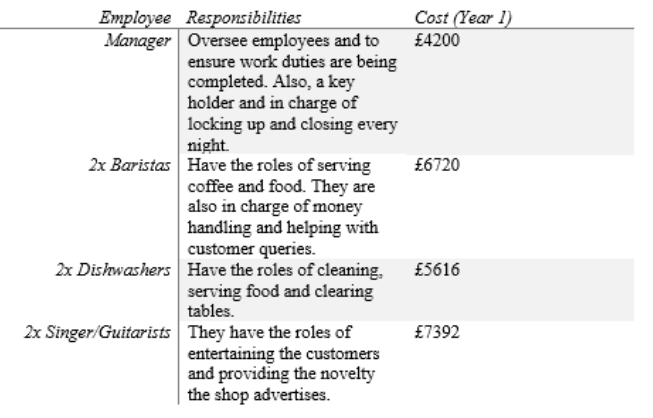 Little Beanie plan to start off with only 7 employees, the minimum that needed to start up the business. Below an outline of what responsibilities, they will have and the cost of keeping them on is provided:
Little Beanie plan to start off with only 7 employees, the minimum that needed to start up the business. Below an outline of what responsibilities, they will have and the cost of keeping them on is provided:
5.3 Premises
The shop will be located at 19 Stone Row, Coleraine, BT52 1EP (Appendix 3). The property is within our budget of £10,000 a year and located a 2min walk from the centre of the town and is easily accessed with a carpark not 100 metres away.
5.4 Capital Expenditure
The following Capital will need to be purchased for the start-up of the company:
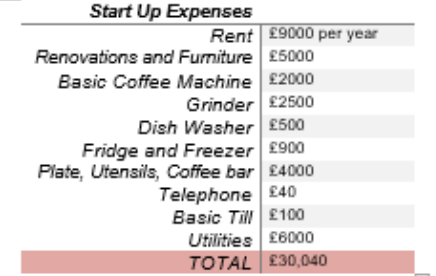
- A loan will be needed, more information 6.1.
5.5 Stock and Suppliers
- Lynas Ltd. – two deliveries, Monday morning and Thursday morning, each delivery is ordered by the manager on Friday before Monday and Tuesday before Thursday.
- Kitty’s Bakery Coleraine – deliver baked goods every morning.
5.6 Insurance
Insurances that will be necessary before opening are
- Public Liability Insurance
- Employers Liability Insurance
- Product Liability Insurance
<Information acquired from SimplyBuisness.co.uk>
5.7 Legalities
- Management of Health and Safety at Work Regulations 1999
- Working Time Regulations 1998
- Environmental Protection Act 1990
- National Minimum Wage Act 1998
- Employments Rights Act 1996
- Employers liability Act 1969
- Also, register with the FSA and obtain a food hygiene certificate.
- Apply for a license to sell hot food and drink at night due to our late-night opening.
5.8 Risks
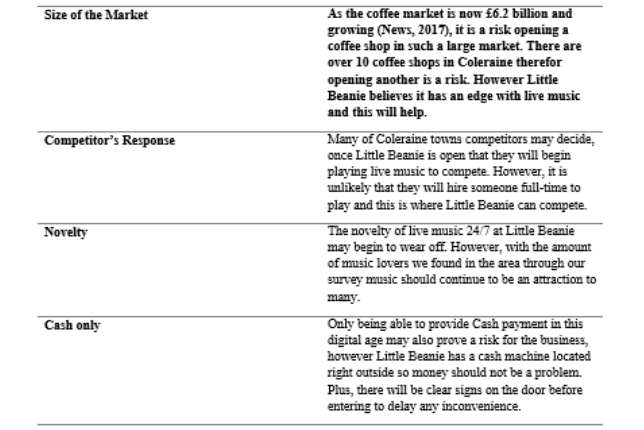 Majority of businesses and companies of all sizes solve problems virtually on a non-stop basis. However, few are a matter of life or death (Kress, 2002) and this is remembered at Little Beanie when reviewing Marketing and Operations planning. Below are possible risks that face the business.
Majority of businesses and companies of all sizes solve problems virtually on a non-stop basis. However, few are a matter of life or death (Kress, 2002) and this is remembered at Little Beanie when reviewing Marketing and Operations planning. Below are possible risks that face the business.
6: Financial Plan
6.1 Funding
To fund Little Beanies a total of £31,000 is needed to start up. The company will acquire this in the following ways:
- Bank loan– first attempt will be to achieve a bank loan of £15,000 from banks like NatWest and HSBC as they are known for helping small businesses.
- Enterprise NI Loan – A loan of £15,000 will be required from the Small Business NI Loan Fund. This loan will be obtained if we are rejected from the banks, as Enterprise NI ensure that businesses are not held back because they cannot access finance. (NI Enterprise, 2017)
- Fundraiser– Little Beanie plans to hold many fundraisers to raise £10,000.
- Owner Investment– Owner Simone Boorman will invests £6,000 of own money to kick-start business.
6.2 Start Up Expenses
Business start-up calculations were made to project what would be needed and how much:
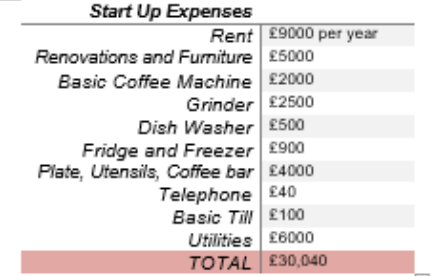
6.3 Expenditures and Income
The first year, Little Beanies income is predicted to break-even and provide profit that will continue the business and help in the long term. Expenditures and income can be seen below with an overall Business Income.
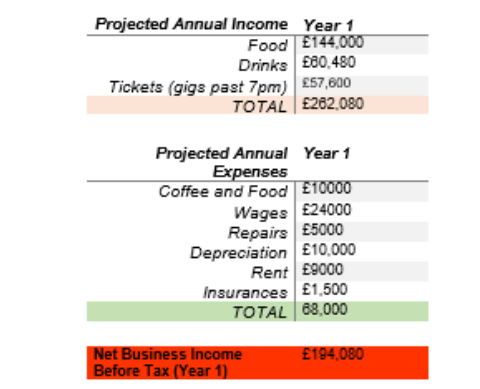
Section 7: Corporate Social Responsibility
7.1 Music Community
Little Beanie promotes itself as a company that works toward their community and believes it has a genuine interest in helping. It does its part in society providing a space for local artists to play. The business plans to work hand in hand with local music programmes and hope to help the music scene by not only paying the artists a salary but also provide a donation box to donate to these programmes.
7.2 Homeless Community
Although it is known that consumers reward companies that engage in CSR, its CSR actions need to be credible if the company expects to reap rewards (Alhouti, Johnson and Holloway, 2016). Little Beanie believes it is credible and proves this through efforts to help the homeless by giving all unused food at the end of the day to them. Secondly they have implemented the ‘Suspended Coffee’ movement allowing customers to have the option to pre-pay for a homeless person coffee in an act of human kindness.
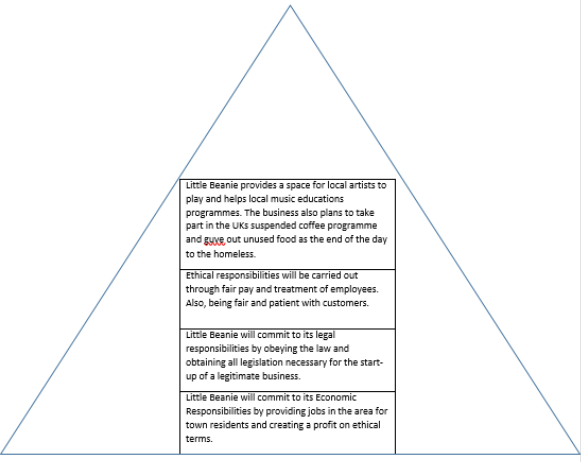 Little Beanie has considered the Carroll’s CSR Pyramid below.
Little Beanie has considered the Carroll’s CSR Pyramid below.
Section 8: References
Alhouti, S., Johnson, C. and Holloway, B. (2016). Corporate social responsibility authenticity: Investigating its antecedents and outcomes. Journal of Business Research, 69(3), pp.1242-1249.
Berger, A., Grigoriev, A. and van Loon, J. (2011). Price strategy implementation. Computers and Operations Research, 38(2), pp.420-426.
Business, S. (2017). Business insurance – Compare quotes – Simply Business. [online] Simplybusiness.co.uk. Available at: https://www.simplybusiness.co.uk/insurance/coffee-shop/ [Accessed 13 Mar. 2017].
Chaneski, W. (2011). Creating a Meaningful Vision Statement. Modern Machine Shop, 83(11), pp.34-36.
Kim, K. and Tsai, W. (2012). Social comparison among competing firms. Strategic Management Journal, 33(2), pp.115- 136.
Kim, Y., Sting, F. and Loch, C. (2014). Top-down, bottom-up, or both? Toward an integrative perspective on operations strategy formation. Journal of Operations Management, 32(7-8), pp.462-474.
Kress, A. (2002). Target market. The Business Journal, 22(45), p.12.
Magdalein, K. (2011). The art of target market prospecting. Life Insurance Selling, 86(5), p.98.
News, L. (2017). UK coffee shop trends for market now £6.2 billion – and growing – Hospitality & Catering News. [online] Hospitality & Catering News. Available at: http://www.hospitalityandcateringnews.com/2014/01/uk-coffee-shop-trends-for-market-now-6-2-billion-and-growing/ [Accessed 8 Jan. 2014].
NI Enterprise, N. (2017). About | NI Small Business Loans Fund. [online] Nisblf.com. Available at: http://www.nisblf.com/about/ [Accessed 13 Mar. 2017].
Stewart-Allen, A. (1997). Marketing Plan. Marketing News, 31(8), p.5.
Stoner, C. (1983). DISTINCTIVE COMPETENCE AND COMPETITIVE ADVANTAGE. Journal of Small Business Management., 25(2), pp.33-39.
Tucker, T. and Duke, L. (2007). How to Develop a Marketing Plan for an Academic Library. Technical Services Quarterly, 25(1), pp.51-68.
Section 9: Appendices
9.1 Appendix One- Surveys
The surveys were created with SurveyMonkey.
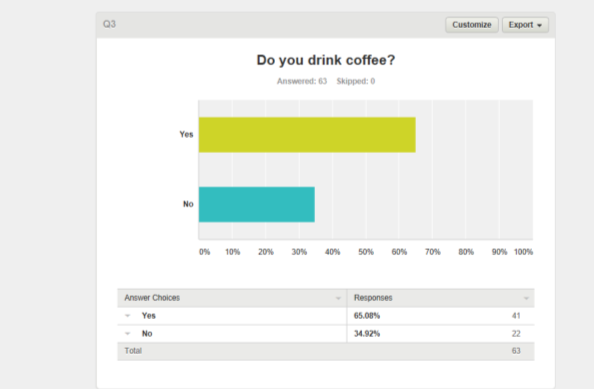
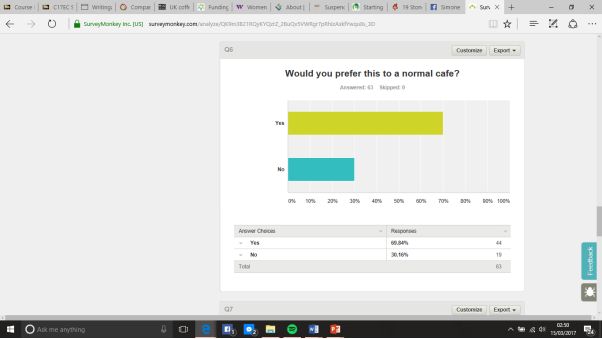

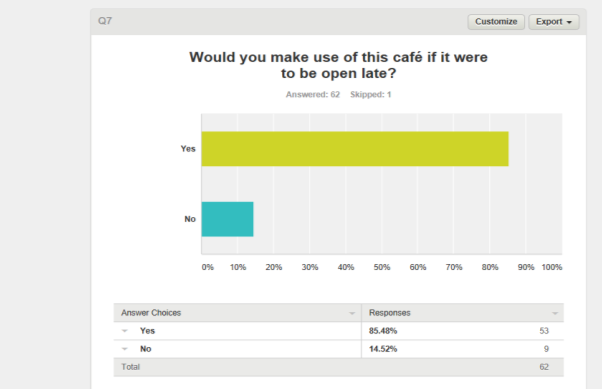
9.2 Appendix 2- Price List
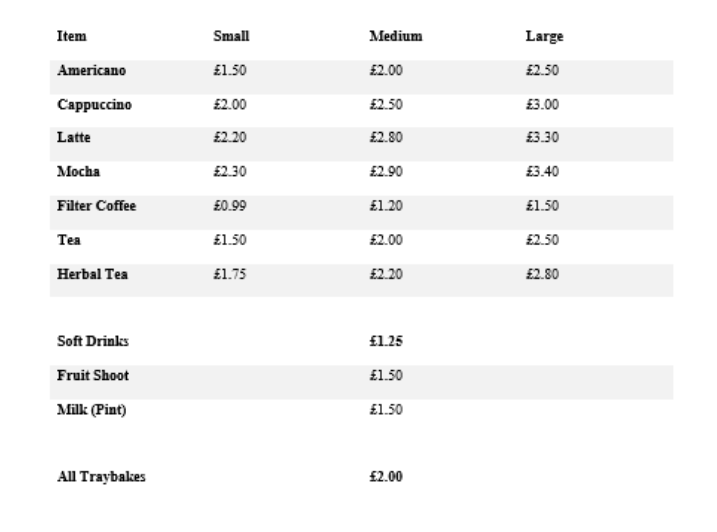
When pricing the companies drinks and food primary and secondary information was used to find what customers would be willing to pay and what competitors are charging for their products. Also, the price of the capital needed to make and continue making the product. Through primary research found through a survey made through Survey Monkey, explained in more detail in our Marketing section, we could find out the most people will pay for a Medium Cappuccino is £2.50/ £3.00, which is slightly cheaper than most other coffee shops allowing us to provide what the customer wants.
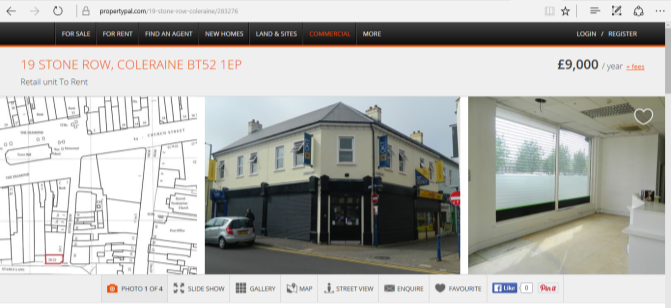
9.3 Appendix 3- Premises